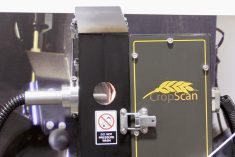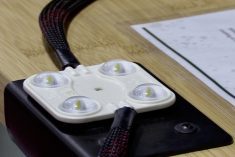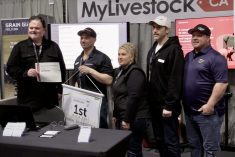Amy Nikkel and her family took up farming, food-processing and grain milling “kind of all together,” she said.
The first year, they grew a crop of gluten-free organic oats, cleaned them and tested products. The next year a flood kept them from planting oats on their Interlake farm.
The third year, they grew another crop, found someone to clean it, retrofitted an old barn into an approved processing facility, purchased dehulling, milling and packaging equipment, designed and printed 10,000 packages, paid for nutritional analysis and shelf-life testing and purchased UPC codes.
Read Also

Finally getting paid for sustainable farming?
Alberta project says they might have a line on a workable ecosystem credit model to reward farmers for sustainability, and Manitoba might be next
“Three years into our project, having worked full time for an entire year, and putting tens of thousands – many tens of thousands of dollars into a business, we then brought our first case of oats to a retailer,” said Nikkel.
“The retailer kind of looked at it, like ‘Hmm, I don’t know. It’s pretty risky. Would you sell it to me on consignment?’”
Why it matters: On-farm processing can be a challenging and rewarding road to travel.
That’s the ugly side of on-farm food processing, Nikkel told her audience at Manitoba Ag Days in Brandon on Jan. 18. She and her family own Adagio Acres, a small farm and grain processor. The good side is the possibility of capturing a far greater portion of the consumers’ food dollars, Nikkel said. It can increase farm stability, even out the peaks and valleys of crop prices, and provide more diverse work tasks, potentially adding more jobs for family members who want to farm.

Analyzing potential
Drawing on her experience, Nikkel offered several considerations to prospective on-farm food processors.
Identify the product: Nikkel suggested farmers consider what crop or variety isn’t available locally (e.g. organic, gluten-free, naked oats), or if a feature of the farm might be valued by consumers but undervalued by the commodity market.
They should also consider how many levels of processing they want to add. Each layer can increase profit share but also complexity and risk, she said.
Identify infrastructure needs: Farming offers potential advantages for processing such as outbuildings and machinery (e.g. a front-end loader for moving pallets). Since farming is capital-intense, it could provide helpful leverage or it could be a burden.
Nikkel suggested talking with food health and safety inspectors before building or buying equipment.
“That was probably the best thing that we did in our entire business startup,” she said.
The inspectors helped evaluate their options, such as whether existing buildings could be retrofitted.
“I think if we had started without asking for that input from the health inspectors, we probably would have started by building our own building, and it really was not required at that point,” she said.
Identify skillsets and labour needs: Some, but not all, skills needed for farming and processing overlap, Nikkel said. Processing doesn’t require skill in agronomy, for instance, but it does require certain mechanical and repair skills, as well as the ability to analyze markets.
Farming requires far less consumer relations, but both require creative problem solving.
Identify your market: Direct to consumer, grocery retailers, food service and restaurants, and export sales all come with their own advantages and disadvantages.
Identify your business structure: A processing business has similar structural options as farming, Nikkel said. For instance, it can be a sole proprietorship, partnership or corporation. It can be separate or combined with the farm.
“Don’t take advice from a farmer,” she said. Talk to an accountant or tax advisor.
Counting costs
Nikkel added a few cost considerations. While farm buildings may be used to set up processing, retrofitting and upgrades are almost inevitable. Other expenses may include capital and maintenance costs for machinery and infrastructure; regulatory costs like third-party audits (e.g. HACCP); material handling and packaging costs; and insurance costs.
[RELATED] Direct farm marketing makes gains in Manitoba
Once a farm has done an inventory and it’s time to make decisions, Nikkel suggested talking with someone who is already doing something similar.
She also suggested taking time to reflect on goals. What do you hope to gain? Is that realistic?
Competitive advantage
Despite its challenges, being both a farmer and a processor comes with competitive advantages, a panel of farmer-processors said.
Paul Spenst of Spenst Bros., Hailey Jeffries of Prairie Fava, and Lawrence Warwaruk of Farmery discussed value-added processing after Nikkel spoke.
Being their own supplier of beef was an advantage for Spenst during the early days of the COVID-19 pandemic, when uneven supply had consumers looking elsewhere for meat.
“You can really fill a need, and then you also create a new customer because they, for the first time out of necessity, must buy your beef,” he said, adding some customers kept buying.
While Prairie Fava is a separate business from the farm, Jeffries said the two work synergistically.
Processing is her business and the farm is her husband’s business. However, the farm produces their preferred variety of fava seed, which they can sell to farmers who contract with Prairie Fava.
Connections with farmers and their supply chain has also been a competitive advantage, Jeffries added. Some companies want to work with them because they want a closer connection with the farmer. They want to know where their ingredients come from and promote that on their packaging.
In Warwaruk’s case, making beer from barley and hops grown on-farm adds value to those products and makes a difference in the community.
















